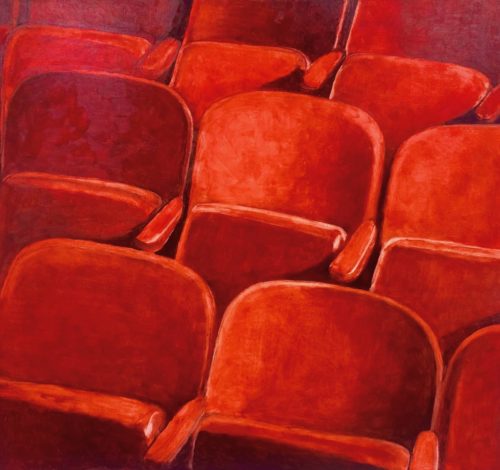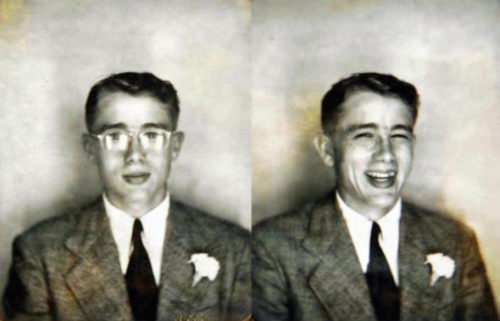
Photographer unknown (Cyanotype, Peter J. Cohen collection).
“We will continue to be your single source of truth… Unless you hear it from us it is not the truth.”
Jacinda Ardern (Speech, 2020)
“The limit of photographic knowledge of the world is that, while it can goad conscience, it can, finally, never be ethical or political knowledge. The knowledge gained through still photographs will always be some kind of sentimentalism, whether cynical or humanist.”
Susan Sontag (On Photography)
”The alleviation of mental distress is only possible “in a society without exploitation and oppression.”
Iain Freguson (Politics of the Mind: Marxism and Mental Distress)
“And when I feel, fair creature of an hour,
That I shall never look upon thee more,
Never have relish in the faery power
Of unreflecting love—then on the shore
Of the wide world I stand alone, and think
Till love and fame to nothingness do sink.”
John Keats (When I Have Fears That I May Cease To Be)
Polaroid photographs possess a very specific and haunting sense of their time. While the first Polaroid *instant* camera (Model 95) came out in 1947, it wasn’t until the sixties really that *Polaroids* became an integral part of American culture. It was popular, too, in Europe, and Asia but not quite like in the US. I remember my father talking about instant cameras when I was still very small. I remember our family having one and my father’s sense of pride in being a part of the currents of progress. But now, when looking back at old Polaroid instant photos, one feels, or at least *I* feel, a certain nostalgia and a sense of melancholy, too.

Melissa Catanese, photography.
The melancholy has to do with a larger sense of the loss, the loss of avant-garde culture, of American optimism from my youth. That promise is captured in polaroids. It is ephemeral but it is unmistakably there. It is why artists such as Warhol and Hockney so loved the Polaroid. My memory of Polaroids was that the experience was tied into the social. It was quite different from having someone take a photo of you with a Nikon F or something. A photo you might never see. Polaroids were there to share in the moment. And this suited the moment of their popularity — the sixties was captured, in a sense, with Polaroids. But the seventies, too.
But I was looking at photographs a lot this week, and two (well three, really) things captured my imagination. One is the remarkable Peter J. Cohen collection of vernacular photographs. If you want a rabbit hole to drop into one day, go browse this collection. From early cyanotypes to polaroids and just family vacation pics, there may be no better guide to the American unconscious than this collection (and vernacular photography altogether). The second was this return to the evolution of instant photography. To the Polaroid era.

Polaroid from Peter J. Cohen collection.
Another aspect of vernacular (and instant…sort of) are photobooth photos. Most come in strips. I have resonant memories of photo booths, and again, of the social. I think many of us remember going to photobooths with teenage girl (or boy) friends. There was something furtive and salacious about pulling the curtain shut and waiting for the warning light and then the flash. There are massive collections of photos taken in photobooths, including celebrities from John F. Kennedy and Jackie on their honeymoon, to Audrey Hepburn, Marilyn Monroe and Salvador Dali. The list is endless. And again, there was something celebratory, nearly always, in going into a booth to take photos. I have some, still, of me and my father. I have others of me with friends. Almost nobody looks depressed in their photobooth portrait. It is in this cultural detritus, if you will, that in memory one can *feel* the loss of optimism.
Richard Avedon’s portraits for The New Yorker were aesthetically mediated by the photo booth. And there was the, in a sense, dark side of passport photography. And booking photos for police stations and prisons. These themes are well documented, and I have written about some of this, too, here in the early days of this blog. And Avedon is mentioned because his work has loomed both as iconic, then disparagingly as voyeuristic, and then perhaps as just too pop. But his best work (IMHO), the portraits he took in Texas, still retain something almost August Sander-like about them. And they also serve as an interesting fixed navigational juxtaposition to vernacular work. The technologically manufactured image has reached a place today, it would be hard to argue against, in which some form of saturation has been reached. I have two thousand pics on my smartphone. Most will disappear when my phone dies and I won’t miss them.

Luisa Ignacia Roldán (La Roldana) (1682, detail, Cadiz Cathedral. Painted wood)
And this quality of documentation has changed, naturally, as taking photos became easier. And one change has been the loss of an actual photographic image on paper, something to be held, usually. Most photos, digital, are saved to be viewed on computer screens. It is difficult to gauge the implications of this; and as is usual these become questions reserved largely for the West. But those photobooth strips remain material facts, somehow, while photos viewed on laptops or larger flat screen monitors, feel less material. And this may signal changes in our memory.
“‘Absolute material accuracy’ was seen as the hallmark of photography because most people at the time accepted the idea that the medium rendered a complete and faithful image of its subjects. Moreover, the nineteenth-century desire to explore, record and catalogue human experience, both at home and abroad, encouraged people to emphasise photography as a method of naturalistic documentation.”
Liz Wells & Derrick Price (Thinking About Photography)
This of course has changed with the onset of digital technology.
“Thus philosophical, technical and aesthetic issues – along with the role accorded to the artist – all feature within ontological debates relating to the photograph. But in recent years, developments in computer-based image production and the possibilities of digitisation and reworking of the photographic image have increasingly called into question the idea of documentary realism.”
Liz Wells & Derrick Price (Ibid)
The photo no longer carries this quality of authority, and it’s possible it never really did to the extent many believed. There has always been a tension between the idea of capturing a reliable reference for truth, of a person or an event, and this insidious suspicion of the counterfeit. Still, that reference to observable circumstances has eroded much further today. And with it, the culture itself is thrown into a position of questioning both the world around it, and itself. On the most recent Aesthetic Resistance podcast (#78, see link at bottom of post) there was a discussion about the most recent statistics in Canada and the US regards prescription of antidepressants and about depression generally. And one need only look at the numbers of homeless in the U.S. and across the EU to grasp the extent of unhappiness in the West today. And this leads, in a not terribly circuitous way to the policies of the U.S. and EU .

Les Krims, photography.
But there are aesthetic links to the political. And there are both psychoanalytical and economic. The digital creation of image, as Rosalind Krauss noted, simply introduces ” the condition of a merely quantitative array of difference, as in series.” All digital photography (sic) is just code, finally.
“If vision can be said to have any enduring characteristic within the twentieth century, it is that it has no enduring features. Rather it is embedded in a pattern of adaptability to new technological relations, social configurations, and economic imperatives. What we familiarly refer to, for example, as film, photography and television are transient elements within an accelerating sequence of displacements and obsolescences, part of the delirious operations of modernization.”
Jonathan Crary (Techniques of the Observer)
But my concern here is with the acute disfunction in contemporary life. Ellis and Price quote Max Kozloff…
“We perceive and interpret the outer world through a set of incredibly fine internal receptors. But we are incapable, by ourselves, of grasping or tweezing out any permanent, sharable figment of it. Practically speaking, we ritually verify what is there, and are disposed to call it reality. But, with photographs, we have concrete proof that we have not been hallucinating all our lives.”
Max Kozloff (Photography and Fascination)

Photographer unknown. (From Peter J. Cohen collection).
This is a profound paragraph, I think. The next sentence, though unwritten, would be that today, we do not even have those rituals, however obsessive and repetitive they may have been. The loss is of a purchase on reality, or what was considered reality. What is the next step after OCD? And here there enters an almost theological discussion. For if we, as a society or culture, can formulate something — however vague — that we refer to with even a modicum of reliability, as *reality*, then it must, of necessity, be imbued with the moral and ethical. What is ripped from us, socially today, is that ability.
“Cameras began duplicating the world at that moment when the human landscape started to undergo a vertiginous rate of change: while an untold number of forms of biological and social life are being destroyed in a brief span of time, a device is available to record what is disappearing. The moody, intricately textured Paris of Atget and Brassaï is mostly gone. Like the dead relatives and friends preserved in the family album, whose presence in photographs exorcises some of the anxiety and remorse prompted by their disappearance…”
Susan Sontag (On Photography)
Some of what make the topographic photographers (Baltz, Adams, Deal, Wessell, Gohlke, et al) so poignant was that they were recording the landscape after the change, after the destruction. Sontag writes only a page or two later…
“The “realistic” view of the world compatible with bureaucracy redefines knowledge—as techniques and information. Photographs are valued because they give information. They tell one what there is; they make an inventory. To spies, meteorologists, coroners, archaeologists, and other information professionals, their value is inestimable. But in the situations in which most people use photographs, their value as information is of the same order as fiction.”
Susan Sontag (Ibid)

Joy Walker
One might also say that photographs help create bureaucracy. They at least refined it, perfected aspects of it. And the ubiquity of the image today is part of this overall reduction in meaning. Sontag would say ‘understanding’. That photos contribute nothing to understanding. Perhaps, but they DO contribute to erasing understanding. And to examine the relationship with moving image, cinema, becomes enormously complex. There is a distinction between the narrative of a still photograph and that of a film. And I think it is true that photographs hide more than they reveal. But what they *do* reveal is unique, and I have a sense that the uniqueness of the photographic image is being eroded by the sheer volume of images. Cinema reveals where the still photo hides. Hence the difference in the quality of narrative. Television and digital moving images reveal even more. And this has an unpleasant (even if marginal) quality about it. In all film there is a hint of surveillance. This is partly a discussion, then, about technology overall, and by extension, it is about AI. The uproar about chatGPT, and its cousins, seems to be missing the more profound issues. Yes, the weird psychotic feeling when reading the writing of Chatboxes is mostly because it reads like a cross between Arthur Bremer’s diaries and official politicians autobiographies, or bureaucratic documents, but there is a layer beneath that disquieting feeling that suggests western populations today are suffering mental breakdowns due to this experience of absent meaning. And it is, additionally, a reminder that on any given day the citizen of the West consumes vast amounts of gibberish.

Richard Avedon, photography.
“Unlike Winston, she had grasped the inner meaning of the Party’s sexual puritanism. It was not merely that the sex instinct created a world of its own which was outside the Party’s control and which therefore had to be destroyed if possible.”
George Orwell (1984)
Sontag notes that increasingly having an experience is identical with taking a photograph of it. This has reached critical mass in the age of the selfie. The digital manufacture of facsimile reality is so at hand (to sort of borrow Heidegger for a moment) that our relationship to the ‘taking’ of the photo (usually with a camera on a smartphone) has blurred into pure communicativity. There is also something else that adheres to the digital smartphone photo, and it is something akin to privilege. Sontag, interestingly, could be a hugely astute critic (even if at other times, like with Artaud, she could utterly miss the point) and her notes on Diane Arbus are very keen observations. And they also anticipate the coming deluge, as it were. Arbus was praised for her unsentimental gaze, but in fact, per Sontag, it was both coy and sinister. And, I would add, it was actually rather hyper-sentimental. In the way only privilege can bestow. Arbus chose to frame her subjects as ‘odd’. And David Lynch is very much her legetee in this sense (as is Jodorowsky). The ‘weird’ effect is pure bourgeois self congratulation.
Sontag rightly suggests that Arbus popularity (which has waned a bit, I think) reveals a tendency in high art today among the educated bourgeoisie. And that is ” to suppress, or at least reduce, moral and sensory queasiness.” This is still true, but because of the shrinkage of experience overall, this suppression has less distance to travel. The point here is that with the onset of mass media, of the internet and the smartphone, the tidal swell of image and information, the impossible amounts of trivial distractions, has meant a sort of flatlining of moral awareness. I read an insightful tweet today from Fiorella Isabel….she writes “Dear U.S Citizens: Your government mocks you. That you aren’t furious Biden flew to Ukraine to commit to more money & support for a corrupt country with paramilitary Nazis in charge instead of helping poisoned citizens of East Palestine, Ohio, says it all. Wake. The. Hell. Up.” I was appearing on Press TV this same afternoon to discuss the Munich Security Conference (Davos for Defense, as its known). And I tried to express the surreality of an Anthony Blinken *confronting* a Chinese diplomat over the weather balloon incident. Meanwhile the U.S. continues to pour billions of dollars into a cynical war campaign and marketing strategy that will cost of the lives of, probably, millions. This on the heels of the pandemic protocols, the trauma of which is barely recognized yet.

Frank Gohlke, photography (Irrigation canal, New Mexico, 1974).
So, this sense I have today — in addition to fertility collapse globally — is that the citizens of the West, at least the U.S., Canada and the EU, have stopped falling in love. Romantic love feels almost like a historical experience. The optimism I remember with Polaroid picture taking, with the Avant Garde, with creativity overall, is gone. And as Johan Eddebo noted in a note to me: “the crisis and the emergency saps all the libidinous energy, which gets directed towards war, towards heroes (Zelenski), and towards the mass mobilization of hatred.”
“But our ability to stomach this rising grotesqueness in images (moving and still) and in print has a stiff price. In the long run, it works out not as a liberation of but as a subtraction from the self: a pseudo-familiarity with the horrible reinforces alienation, making one less able to react in real life.”
Susan Sontag (Ibid)
This loss of trust in culture coincides with a loss of desire. And more particularly a sense of a society having fallen out of love with love.
It is worth noting here the evolution of treatment for mental illness, in particular depression. And the role of Big Pharma in encouraging an *objective* set of symptoms and treatments.
“Sometime in the 1970s was taken over by neuroscience and an “objective” prescription of pills. An important part of this was the development, and transformation of, the American Psychiatric Association’s Diagnostic and Statistical Manual of Mental Disorders (DSM). The first edition was published in 1952 and was largely made up of psychoanalytical disorders that “assumed presenting symptoms, and, indeed, personality itself, to be the result of early life con-flicts that were mapped onto the unconscious psychical apparatus for the remainder of life.” In the 1970s, however, a series of randomized clinical research studies revealed the benefits of biological psychiatry and psycho-pharmacology.”
Fredrika Thelandersson (21st Century Media and Female Mental Health: Profitable Vulnerability and Sad Girl Culture)

Jess Allen
“As Appignanesi critically points out, two important driving forces behind the remaking of the DSM and the turn towards a biological psychiatry were pharmaceutical and insurance companies. “Big Pharma” requested standardization of disorders so as to be able to show medication’s efficiency with particular demographics, and insurers wanted measurable symptoms/illnesses so as to regulate their payments.”
Fredrika Thelandersson (Ibid)
The role of Big Pharma and Insurance companies cannot be overestimated here. But it raises more difficult questions about the nature of mental health. And when looking at the trauma caused by the Pandemic protocols and lockdowns it is not difficult to understand why the sales of anti-depressants has risen so dramatically.
Thelandersson adds “A cynical reading of this kind of treatment is that a prescription and ten sessions of CBT makes the patient ready for the labor market again.”
The idea that was promoted, among others, was that psychoanalysis was fuzzy and unscientific and that the new objective truth of biology was there to replace the uncertain influences of family and abuse. Objectivity was there to correct biases about gender. And about childhood. Biological explanations for mental health dominate discourse in Western society today.
“Some sense of the degree of collusion that exists between psychiatry and “Big Pharma” is shown by the fact that of the authors who selected and defined the DSM-IV psychiatric disorders, roughly half have had financial relationships with the pharmaceutical industry at one time, raising the prospect of a direct conflict of interest.66 The connections between panel members involved in contributing to the DSM and the drug companies were particularly strong in those diagnoses where drugs are the first line of treatment, such as schizophrenia and mood disorders, where 100 percent of the panel members had financial ties with the pharmaceutical industry. ”
Iain Ferguson (Ibid)

Diego Velasquez (Virgin of the Immaculate Conception, 1618) detail.
“A mental-health crisis is sweeping the globe. Recent estimates by the World Health Organization suggest that more than three hundred million people suffer from depression worldwide. Furthermore, twenty-three million are said to experience symptoms of schizophrenia, while approximately eight hundred thousand individuals commit suicide each year. Within the monopoly-capitalist nations, mental-health disorders are the leading cause of life expectancy decline behind cardiovascular disease and cancer. In the European Union, 27.0 percent of the adult population between the ages of eighteen and sixty-five are said to have experienced mental-health complications.”
David Mathews (Monthly Review, 2019)
The irrationality of capitalism is such that even leisure time today (ever shrinking anyway) offers little consolation from the trauma of daily life. People retreat more every day into private worlds of isolation and anxiety.
“While fulfilling the basic needs of survival,” Baran and Sweezy argued, both work and consumption ‘increasingly lose their inner content and meaning.’ The result is a society characterized by emptiness and degradation. With little likelihood of the working class instigating revolutionary action, the potential reality is a continuation of the ‘present process of decay, with the contradictions between the compulsions of the system and the elementary needs of human nature becoming ever more insupportable,’ resulting in “the spread of increasingly severe psychic disorders.”
David Mathews (Ibid)
Mathews adds “Marx, capitalism separates individuals from their essence as a consequence of their existence.” This speaks to the ersatz biological objectivity inherent in the Big Pharma influence on mental health. And the death of love and optimism.
Mathews then quotes Erich Fromm “Aware of being alone in the world, humans strenuously endeavor to establish ties of unity. Without this, it is intolerable to exist as an individual.”
(The Sane Society)

Polaroid (PeterJ. Cohen collection)
The tendency of the current institutions of the ruling class is to enforce rules against unity. Of any kind. In that sense the lockdown protocols were almost a symbolic distillation of the values and fears of the ruling class. The culture of the selfie, the obsessive reproduction of self advertisements, in essence, are band-aids for the lacerating loneliness most people feel today. And it further reinforces this idea of hyper individuality, as well as reinforcing a deeper deformation of what constitutes reality. At the same time the government assiduously works to undermine all collectivity and group formation. It’s also apparent that the spectator sports domain is there to mimic collectivity and provide just the most basic ephemeral experience of belonging. This segues into the current war cult being inflamed by the US government.
“When considering the role of the pharmaceutical industry in psychiatric research, it is important to recognise that the industry’s main purpose is to make money for its shareholders. Drug companies are no more driven by the desire to do good than the manufacturers of automobiles, canned soup or other household products… ”
Richard Bentall (Doctoring the Mind: Why Psychiatric Treatments Fail)
When one reflects on the shaping of opinion regards Covid and the protocols, and then on the Russia/Ukraine/NATO conflict, it is stunning that the obvious mendacity of corporations and governments should have so little traction– the public seems to want to believe in corporate good will. And it should be increasingly obvious that capitalism engenders trauma, especially on the young. And yet, in the U.S., certainly, belief in capitalism has never been higher.

Tsuruko Yamazaki
“The evidence is that all the structural and functional differences between the brains of “schizophrenics” and “normal” adults (which are cited to support the “brain-disease” hypothesis) are the same differences found between young children who have been traumatised and those who have not.”
John Read (Models of Madness)
As birth rates fall across the planet, particularly though, in the West, a recent PEW survey found that half of representative adults in the U.S. had no interest in finding a partner, a date, or romance. And it should be noted that while the economy plays a huge role in this, the most common dating practice today is connected to ‘dating aps’ where one selects possible hook ups from the *photo* of the individual. The photograph looms over this, yet again.
After watching an early silent film (the story is it was a film by the Lumière brothers) Maxim Gorky commented (quoted in James Elkins On Photography):
“This mute, grey life finally begins to disturb and depress you. It seems as though it carries a warning, fraught with a vague but sinister meaning that makes your heart grow faint.”
The imposition of the technical image on our life, on our unconscious, is something yet to be resolved, I think. It is interesting, in a sort of side bar, that if you read art critics (something I do rather a lot) you notice after a while that art photographers tend to always get harsh treatment.Far harsher than is handed out to, say, bad installation art or video art. Let alone painting. I suspect this is because of several related factors. First is the surveillance-like quality of all photos. Its there in the background, often, the far background even, but its there. Second is the quality Gorky describes, which admittedly is more acute in movies. And thirdly is the potential for documentation of actual horror. Bataille spent a good deal of time on the infamous/famous *Lingqi* torture/execution photographs from Beijing circa 1904. There are apparently several sets. This is the Chinese *death by a thousand cuts*. And such photos, as many medical abnormality textbook pictures, are truly horrific to look at. Medical photos of acute birth defects elicit the same revulsion. The *Lingqi* photos are different, though, because they also draw the viewer in. One wants to know what death looks like and this may be as close as one can get. This potential is latent in all photographs. All technical images are haunted by a latent horror.

Shozo Shimamoto
“It is abundantly clear to any thoughtful observer of the psychiatric scene that drug company influence is now pervasive. Between 1993 and 2001 prescription drug spending tripled in the United States – from $50 billion to 150 billion or more (Szegely-Marzak 2001). In 2000 psychotropic drug sales in the United States totaled $23 billion. Between 1990 and 2000 spending on antidepressant drugs rose 800% (Tanouye 2001). Over the same period the availability of the new ‘atypical’ antipsychotic drugs caused spending on neuroleptics to rise 600%, to 4 billion dollars in 2001 (Moukheiber 2001). The successful selling of ‘atypical’ antipsychotics, the reason for this 600% rise – to replace the older, no longer patented, neuroleptics, is the major focus of this chapter. One indication of the success of the selling of the ‘atypicals’ is the increase in use of antipsychotic drugs in youth (under 18). In 1992, 50,000 youth outpatients received them; by 2002, the figure had reached 530,000 (Thomas 2002).”
John Read (Ibid)
I think it’s important to remember that the ruling class are subjected to many of the same traumas, even if they are the ones designing them. Even if the idea is to punish the poor. They suffer too, only their suffering is experienced with even less understanding. If I try to imagine what is in the mind of Victoria Nuland or her husband, or Ursula van der Leyen, or Marc Benioff, I have a hard time coming up with any idea or picture. I think this is tied into changes in how people *believe* today. This came up in the podcast recently. I think society has arrived at a place where cognitive dissonance is endemic.
The saturation of image today results in a collective stupor. Difference is ever less significant. As Debord said, ‘what appears is good, what is good appears’. Returning to Sontag, the photographic image IS reality. The images from Abu Ghraib caused a sort of mock outrage, but it disappeared soon enough. The proliferation of glossy photoshopped imagery has been critiqued extensively, but these critiques have begun to feel beside the point. The marketing objectification of women feels true but less relevant given that nobody experiences desire anymore. Or they do not experience it intensely. The spectre of a ubiquitous porn industry has colored desire.

James Dean in photobooth.
It is worth reading again the now famous Marcia Angell NYRBs article from 2011
https://www.nybooks.com/articles/2011/06/23/epidemic-mental-illness-why/
Because there is a paywall I will pull a couple quotes:
“The shift from “talk therapy” to drugs as the dominant mode of treatment coincides with the emergence over the past four decades of the theory that mental illness is caused primarily by chemical imbalances in the brain that can be corrected by specific drugs. That theory became broadly accepted, by the media and the public as well as by the medical profession, after Prozac came to market in 1987 and was intensively promoted as a corrective for a deficiency of serotonin in the brain. The number of people treated for depression tripled in the following ten years, and about 10 percent of Americans over age six now take antidepressants. The increased use of drugs to treat psychosis is even more dramatic. The new generation of antipsychotics, such as Risperdal, Zyprexa, and Seroquel, has replaced cholesterol-lowering agents as the top-selling class of drugs in the US.
What is going on here? Is the prevalence of mental illness really that high and still climbing? Particularly if these disorders are biologically determined and not a result of environmental influences, is it plausible to suppose that such an increase is real? Or are we learning to recognize and diagnose mental disorders that were always there? On the other hand, are we simply expanding the criteria for mental illness so that nearly everyone has one? And what about the drugs that are now the mainstay of treatment? Do they work? If they do, shouldn’t we expect the prevalence of mental illness to be declining, not rising?”
Marcia Angell (The Epidemic of Mental Illness, Why?)
It is worth noting that Angell points out that the first generation of psychoactive drugs were not developed to treat mental illness. They were anti-infection drugs that were discovered to blunt certain symptoms associated with schizophrenia and related conditions. What in effect happened was that because Thorazine reduced dopammine, it was postulated that excess dopamine caused psychosis. When it was discovered that certain antidepressants increased serotonin in the brain, it was postulated that too little serotonin caused depression. As Angell puts it: “Thus, instead of developing a drug to treat an abnormality, an abnormality was postulated to fit a drug.”
As one doctor noted, this is like saying fevers are the result of too little aspirin.

Ingmar Alge
Angell is reviewing several books in this article. One of them is Irving Kirsch’s fascinating The Emporer’s New Drugs. Kirsch studied the effects of placebos, mostly.
“Faced with his findings that nearly any pill with side effects was slightly more effective in treating depression than an inert placebo, Kirsch speculated that the presence of side effects in individuals receiving drugs enabled them to guess correctly that they were getting active treatment—and this was borne out by interviews with patients and doctors—which made them more likely to report improvement. He suggests that the reason antidepressants appear to work better in relieving severe depression than in less severe cases is that patients with severe symptoms are likely to be on higher doses and therefore experience more side effects.”
The take away is that if you gave people black tea but told them it was an anti depressant and might cause them to have trouble falling asleep at night, they would report improvements in depression. Also, as Robert Whitaker has noted, mental illness has risen dramatically over the last four decades. So has chemical treatment. And this begs the question why episodes of even severe depression, in the past, often disappeared over time. Or were episodic. While today depression is more acute and much longer lasting. The conclusion is that the treatment is actually making the condition worse, even if, briefly, the treatment reduces symptoms.
“With long-term use of psychoactive drugs, the result is, in the words of Steve Hyman, a former director of the NIMH and until recently provost of Harvard University, “substantial and long-lasting alterations in neural function.” As quoted by Whitaker, the brain, Hyman wrote, begins to function in a manner “qualitatively as well as quantitatively different from the normal state.” After several weeks on psychoactive drugs, the brain’s compensatory efforts begin to fail, and side effects emerge that reflect the mechanism of action of the drugs. For example, the SSRIs may cause episodes of mania, because of the excess of serotonin. Antipsychotics cause side effects that resemble Parkinson’s disease, because of the depletion of dopamine (which is also depleted in Parkinson’s disease). As side effects emerge, they are often treated by other drugs, and many patients end up on a cocktail of psychoactive drugs prescribed for a cocktail of diagnoses. The episodes of mania caused by antidepressants may lead to a new diagnosis of “bipolar disorder” and treatment with a “mood stabilizer,” such as Depokote (an anticonvulsant) plus one of the newer antipsychotic drugs. And so on.”
Marcia Angell (Ibid)
There are other studies that suggest patients on multiple anti-depressants and mood elevtors exhibit a brain shrinkage. Nancy Andreasen explained to The New York Times, “The prefrontal cortex doesn’t get the input it needs and is being shut down by drugs. That reduces the psychotic symptoms. It also causes the prefrontal cortex to slowly atrophy.”
By the by, the most widely prescribed of the new generation of anti-depressants was Zyprexa, which also happened to cause enormous weight gain. But fear not the FDA just approved several *new* anti-depressants, of which the most popular is simply a combination of two older ones. Oh also, sexual dysfunction is a common side effect.
This is, of course, but one aspect of the stupification. What Debord called the generalized autism of the populace today. There is something more philosophically profound occuring that happens or is happening behind the specifics of treatment statistics. And it is tied into aesthetics and theology, and to desire. And maybe more acutely, has rearranged the civilizational relationship with love. And it feels as if love is itself always a narrative. Romantic love, that tied to family and procreation, has been sub-contracted to dating ‘aps’, if it exists at all.
Photography has from its very inception narrated an upward class gaze or a downward class gaze. There was a bourgeois perspective that the technology itself imposed. James Elkins discusses this via Baudelaire and the flaneur, from Atget to Weegee to Genthe; there is something inescapably voyeuristic embedded in photographic art (and journalistic photography which overlap rather routinely).
“The flâneur is not attracted to the city’s official realities but to its dark seamy corners, its neglected populations—an unofficial reality behind the facade of bourgeois life that the photographer ‘apprehends,’ as a detective apprehends a criminal.”
James Elkins (On Photography)

Weegee, photography.
At the same time, the photographic gaze has never not been intoxicated by wealth. The erosion of photographic authority runs alongside the elevation of photographic interchangeability with whatever we mean by ‘reality’. That sense of criminality is something Lacan noted, and something even the Frankfurt School thinkers sought to examine. This fungible sense of ‘the real’ has, as I noted, stripped the last remnants of the moral from creativity. The fact that modernism was a project keenly secular probably plays a role in this. The pre-conditions for love have been damaged, at the least, and the truncated narratives of ‘entertainment’ have reduced courtship rituals to cartoons.
And infantilism. A society now led by the infantile. Zelensky appears like a delinquent schoolboy sitting in detention after class. Sean Penn and Zel pose for bicep portraits. Biden can hardly walk in a straight line. Kamala Harris appears like a bewildered ten year old caught stealing candy. Blinkin, Jake Sullivan, Hunter Biden, Sunak…these are not grown men. As James Kuntsler noted, these CANT be the guys making the decisions. They must be someone behind them. Yes, almost certainly, but they are children, too. Bill Gates is not an adult. Elon Musk? I don’t think so. Jeff Bezos? No. We live in a post modern version of Marat-Sade by way of Lord of the Flies.
The lockdowns traumatized society in ways yet to be fully understood. But certainly the young were most severely affected:

Banks Violette
The loss of an aesthetic education, even a rudimentary one, is tied directly into societal trauma. The public is woefully inarticulate about their own suffering. There is a loss of ability in narrating one’s own life. A loss of moral awareness. In substitution for this comes hurt feelings, and mock indignation.
“You stole my dreams and childhood…”
Greta Thundberg
This is the voice of privilege. You can hear it everywhere today. It is, as I noted on the podcast, borderline sociopathic, actually. It is a frightening expression of entitlement. It is marketing. It is branding. It is not revolution or revolt. Shopping for pronouns is not resistance. Amid the psychological wreckage of the pandemic shutdown is numbness.
There is a massive traumatization of society over the last three years. Recovery is being compromised. And adolescents are killing themselves. Teens are encouraged to embrace confusion, to embrace medical treatments that harm, not cure. The homeless population is so large that it serves as simply backdrop. All of it is Biblical in scope. This is an allegory akin to the Old Testament.
“Now therefore kill every male among the little ones, and kill every woman that hath known man by lying with him.”
Numbers 31:17
“Therefore, behold, I will bring evil upon the house of Jeroboam, and will cut off from Jeroboam him that pisseth against the wall, and him that is shut up and left in Israel, and will take away the remnant of the house of Jeroboam, as a man taketh away dung, till it be all gone.”
Kings 14:10
Billions and billions of dollars a day are given over to the research and development and building of machines made to kill and maim. Money in the hands of sociopaths. By emotionally damaged sadists like Nuland and Blinken and Sunak and Macron. And by Blackrock and Vanguard. They own the world. And this resembles nothing so much as the rise of the Reich. And this is hardly surprising because the Nazi party loyalists were brought to the U.S. and given jobs (to the USSR, too, only not to the same degree). The Reich was absorbed and re-branded. Project Paperclip remains a story few seem to notice. The western ruling class LIKED the Nazis. As Adorno and Horkheimer noted, anti-semitism increased after Auschwitz, it didn’t decrease. The forces that created fascism have not disappeared.
To donate to this blog and the Aesthetic Resistance podcasts, use the paypal button at the top.
https://soundcloud.com/aestheticresistance/podcast-78

Thank you for this. The suggestions you raise here raise memories of my own experiences of romantic love which seem now – sadly – as if they happened in another dimension. I’m curious how Dave Hickey’s Air Guitar would add or subtract to your analysis (having lost my copy some 20 years ago, I can’t investigate this myself at the moment). I would hate to take on the task of tracking the content of today’s love songs, and I have a recollection that Horkheimer and Adorno hated the Great American Songbook. But there’s no denying that love songs have played a critical role in our cultural expression of love, for good or for bad. Much like Polaroids, the arguably social technologies of radio, corner juke-box, and family stereos have transitioned into people listening to their favorite romantic songs, alone in their cars, with their ear buds securely fastened.
“There is a massive traumatization of society over the last three years.”
I used to “deconstruct” the various articles that the media has aggressively pushed over those years. But they became so numerous that I rapidly felt it all to be futile. Indeed, I come to feel that such deconstruction was ironically adding substance to the attack against me.
And with recent months there seems to be an acceleration of idiocy now taking place such that covid now appears as merely the initiating point. Today I experienced something that was utterly ludicrous: I actually felt a nostalgia for the spring of 2020 in which “the pandemic” was at least a centralised narrative. The ensuing gaslighting with climate catastrophe, proposed insect food, the increasing emphasis on transgender ideology, the cartoonish anti-Russian propaganda, the frankly embarrassing elevation of the comedian Zelensky into a hero, the doom mongering with e.g. envisioned asteroid collisions etc. – all this has created a kind of hallucinatory dizziness where it is easy to feel the collapse of the last vestige of phycological/social stability.
As dark as some of the ideas can be, your blog always gives off a little jouissance. The discussion of photography brought up so many memories of childhood in the 80s and 90s, when Polaroid hit its peak revenue and then sharply declined. One of my friends was actually part of a movement to revitalize Polaroid photography in SF and they would meet up regularly. She even did a radio documentary (including an interview with Gus Van Sant): https://soundcloud.com/modernpolaroidlovestory
It’s always the photographs you didn’t take that sometimes haunt you. There was a friend of a friend when I lived in Seattle who had this spectacular downtown penthouse filled with art but I think his most prized (and quite prominently displayed) works was the 3 photos of himself taken by his old friend Dick Avedon (this is a guy who drops more names in 5 minutes than most people do in a lifetime). It was kinda like a mini Zoetrope. Every time I was at his place I wanted to covertly take a picture of him next to his Avedon portraits with my phone but only if I he was unaware — I always thought that would be interesting contrast since he was so clearly overly posed in the Avedon photos. But moment never arrived.
These discussions about “mental illness” and psychiatry always hit home because my brother’s life was destroyed by the pharma complex and psychiatrists. In fact that last quote from Angell starting “With long-term use…” describes exactly what happened to him — and I knew they were ruining his life and I couldn’t do anything. It got to the point where if you talked to him on the phone the only things he would talk about were his new diagnoses, new drugs they prescribed him, and then on top of that he kept changing psychiatrists … it was so very sad and also incredibly boring to talk to him because he had nothing else he wanted to talk about except his adventures in this world of drug pushers.
I always liked Robert Bly’s concept that depression is an entity on it’s own and that we are in some ways built for depression, that it just comes to you now and then, but of course he said he was never depressed when he was writing poetry… Although I cleared up some or most of my traumas and mild psychoses (we all have them) by wandering through Thailand for 6 months years ago and learning vipassana and such, I was always curious about therapy/psychiatry (especially because of my brother) and actually once set up a couple appointments with a cognitive therapy practitioner at this big clinic my employers insurance covered (other than this I quit Western medicine in 2006 completely and stopped taking vaccines when I was 20)… I actually liked talking with the therapist and I think we got along well and actually I think we could have accomplished more just chatting in a cafe … the talk was therapeutic but the clinical setting, I felt, made me think when I went there that I might (or “should”) have something these people would diagnose. Apparently I circled the wrong numbers on the surveys during the 6 or so appointments I had and so she thought I might need further treatment and referred me to this psychiatrist. He had this office that seemed with the lighting and objects to be a little intentionally Lynchian “weird” like he thought he was Dr. Lawrence Jacoby from Twin Peaks. Our conversation was really brief and I didn’t get a good vibe from this guy — and then at the end he says he’s going to write me a prescription — after 45 minutes and I went hmmmm. I remember asking him why he thought this particular pill would benefit me and if I recall right he basically said “well we’ll try this and if it doesn’t work we’ll try something else …” I got the little pills and took them home and dumped them on the kitchen counter and asked myself how they could possibly improve my mind or whatever. I took one for luck and threw the rest away and have not sought out “treatment” again.
I’m sorry to hear that about your brother. I’ve sadly heard many such stories. And I’ve known people who went through years of various cocktails of antidepressants, mood elevators, etc. Mostly nothing much changed except they got fat and moved around more slowly. I remember Bly talking about Vietnam, after the war, and how soldiers would suddenly sort of start releasing this pent up rage at the country that sent them to this pointless war. How they would interrogate themselves aloud. He said it felt like a form of psychotherapy done by one person with himself.
I always appreciate your thoughts, george. This one especially.
“. At the same time the government assiduously works to undermine all collectivity and group formation. It’s also apparent that the spectator sports domain is there to mimic collectivity and provide just the most basic ephemeral experience of belonging. This segues into the current war cult being inflamed by the US government.”
Every single prescription to deal with the alleged pandemic masks, social distancing, venue shut doens, etc. was anti-collective, designed to rupture our human bonds. The Chief Health Officer of NSW, Australia, cautioned people against speaking to their neighbors.
https://www.theblaze.com/news/australian-health-officer-do-not-talk-to-each-other
Hi John. I noted that someone in your latest aesthetic resistance podcast (no. 78) makes the observation that, in a recent exchange, he was confronted by another who simply exploded in anger with about four different claims, none of which seemed rational and all of which led to a massive multiple contradiction. And the speaker noted that the four memes the opponent was spouting were simply mainstream media incantations which had clearly been imbibed without any critical awareness.
And this is the worrying thing: the covid con initiated a vast psychological reconfiguration in which any previous critical faculty has now been completely trashed as a large portion of the public (I hesitate to say “the majority” since the media not only has almost a monopoly on “The Truth” but can also convey a distorted sense of the public reception) were traumatised into a kind of second childhood.
They have succumbed because the media exerted an unprecedented monolithic control over a monomaniacal narrative. This media also blocked out anything that contradicted that narrative e.g. the accumulating vaccine deaths. The blocking continues whilst utter non-news, such as “deadly” passing asteroids, gets the front page.
And now the covid tale seems to have been ditched without explanation though the changes pushed through on the back of it, of course, remain. The aim of this psycho-terrorism has been achieved as the media now move on to other strands from their “box of tricks”.
The overall result of all this has been devastating. The site Off-Guardian used to post items and list comments from a varied opposition which included many Marxists. When the covid operation started, the site aggressively implemented a rejection of the covid narrative which I salute. However, this seems to have had the effect of repelling these Marxists, all of whom succumbed to the narrative. The consequence has been a site which can see through the obvious nonsense of the media but most of whose commenters don’t seem to have the background structural awareness to understand why all this is happening.
Consequently, we have all sorts of occult interpretations, capitalist apology, curses against “encroaching communism” and a general jeremiad against “collective thinking” etc. Meanwhile the departed Marxists now appear to be posting elsewhere to complain about the “tin foil hat nutters” on Off-G. (And the trouble is that they are sometimes right.)
The covid operation was very well played.
Agreed. First off, I was very sad that Off G turned out to be run by a rabid anti communist (anti marxist etc). And its complicated by the fact that so many on the left (sic) got the covid story so wrong (see WSWS, gowans, jacobin, counterpunch etc). Now CP is a lost cause these days, they get everything wrong including NATO/Ukraine and climate. I was attacked for insulting Greta. (!). Christian Parenti has a great article on the failure of the left regards this. https://thegrayzone.com/2022/03/31/left-covid-lockdowns-mind-autopsy/
Now, a lot of the hardcore left would not share the parenti piece because they wont go along with the grayzone. All this purism is very tiring after a while. Fact is, grayzone has been pretty good these last couple years. Anyway, when I spoke at the stockholm conference on vaccine mendacity etc, I heard from all the doctors how exhausted they were from the constant attacks against them. The media really circled the wagons and carried out the master narrative in a very rigid and comprehensive manner. And then the media also promote people like jordan peterson, who is truly a moron, as the poster boy for public intellectual. The mind reels. And his anti marxism is hysterical and totally based on the worst reactionary state department histories available. I saw today again, on social media, people i know and think of as intelligent promoting those anthony sutton’s histories. (thankfully max parry has a nice takedown of that stuff…on Unz. And i get why people wont want to read Unz….but there you have it.). Giorgio Agamben’s book Where We Are Now is essential reading, I think. And he is attacked now, too. But i said the other day that capitalism has never been more popular, even among those who somewhat questioned the covid story. Now, we have the Ukraine narrative and I have honestly never seen this level of propaganda on a single topic. And I hear constant outcries about Russian imperialism. When one tries to point out its the US with 900 out of country military bases, it simply falls on deaf ears. The Russophobia is stunning, honestly. And stupid. (Degas having his painting retitled Dancer in Ukraine Dress where it was titled, before, by the painter himself, as Russian Dancer). Its freedom fries on steroids. But I am expecting a huge deluge of climate restrictions on the horizon. Travel restrictions in particular.
After expressing my frustration with Off-G I only just now caught this dismal essay in the comments. Needless to say, the “Peterson” referred to is Jordan:
“I like it when Peterson speaks of personal responsibility, self-reliance, focus on self, being in control of oneself, stuff like that. That’s right on and that’s ultimately the way for humanity out of this collectivist mess toward a hayekesque spontaneous order in which society is an assemblage of individuals, in contrast to the collectivist borg where individuality doesn’t exist, which is where things are heading right now.”
Now that’s the kind of dross I may have responded to pre-covid. (“a hayekesque spontaneous order”? Seriously?) But now I fail to see the point in even considering this turgid guff.
One writer I am coming to appreciate more is Theodore Adorno – though I’ve always had a “love/hate” feeling about him. He can write beautifully and with immense poignancy. (His book on Mahler is a masterpiece.) And then he exasperates me. But that is his way of respecting the reader. He is serious and demands seriousness in return. Robert Hullot-Kentor has a very good book relating to Adorno: “things beyond resemblance”.
Have you encountered the book “Grand Hotel Abyss: The Lives of the Frankfurt School” by Stuart Jeffries? It may be taken as a “popularisation” of its subject. I reckon Adorno would have hated it.
Cheers. Thanks for your response. Of course my brother and I grew up near the Blys but had vastly different outcomes. Interestingly, my brother was a very very good actor in high school and the drama director in our little high school near Robert Bly’s house was the guy who cast Jessica Lange in her first high school plays as well. One of my brother’s most memorable roles was as Bo Decker in Inge’s Bus Stop. He later taught Inge and other American playwrights when he was a PhD student just before he got swept under “mental illness”.
It is interesting the people who fall under the sway of “mental illness” and then those who fell for the BIG SCARE over the last few years. The fact that millions of us saw it for what it was right from the start never matters. It hurts so much to lose friends you thought you had for a lifetime and they seemed to be capable of independent thought and then they fell for the cult.
“After you have finished your true stories sometime, why don’t you make up a story and the people that go with it? Only then will you understand what happened and why. It is those we live with and love and should know who elude us.”
i have quoted that hullot kentor book probably as much as any book on this site. Read Adorno’s late lectures, there are three volumes I think. All are excellent. And Minema Moralia, too, of course.
and…the peterson thing is predictable. I mean he was invented, in a sense, to appeal to a certain middle mind (see curtis white’s old essay )
It was falling out of love with the soft Valkyres
of the High School plays- South Pacific, The Sound of Music, Oklahoma,
ad nauseam. Almost post-polaroid Grease & Breakfast too.
Plato worried about Music corrupting “youth”.
But I never felt cleaner than I picked rare cultural nuggets like
Quicksilver MESSENGER Service’s “What About Me” or “Fresh Air”
slapped me in the night beach. I still long for such music
today in the digital wasteland.
I too want scream again “Goddamn THE Pusher Man! ”
https://www.transcend.org/tms/2023/02/we-are-being-smashed-politically-economically-medically-and-technologically-by-the-elites-great-reset-why-how-do-we-fight-back-effectively/
Creation Through Rare Quantum Tunneling
& Interpersonal Miracles Often Occurs-
https://www.msn.com/en-us/news/technology/for-the-first-time-ever-physicists-see-molecules-form-through-quantum
-tunneling/ar-AA18739X?ocid=msedgdhp&pc=U531&cvid=1e93d48f2dc14f04ac2fe910319197d3&ei=9